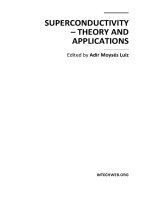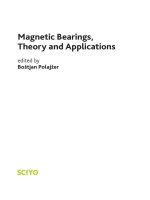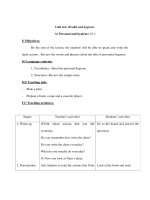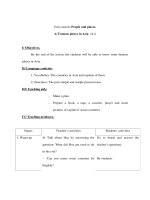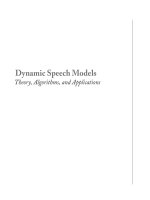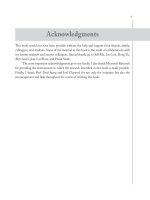Dynamic Speech ModelsTheory, Algorithms, and Applications phần 1 pot
Bạn đang xem bản rút gọn của tài liệu. Xem và tải ngay bản đầy đủ của tài liệu tại đây (150.77 KB, 10 trang )
P1: IML/FFX P2: IML
MOBK024-FM MOBK024-LiDeng.cls May 24, 2006 8:16
Dynamic Speech Models
Theory, Algorithms, and Applications
i
P1: IML/FFX P2: IML
MOBK024-FM MOBK024-LiDeng.cls May 24, 2006 8:16
Copyright © 2006 by Morgan & Claypool
All rights reserved. No part of this publication may be reproduced, stored in a retrieval system, or transmitted in
any form or by any means—electronic, mechanical, photocopy, recording, or any other except for brief quotations
in printed reviews, without the prior permission of the publisher.
Dynamic Speech Models, Theory, Algorithms, and Applications
Li Deng
www.morganclaypool.com
1598290649 paper Deng
1598290657 ebook Deng
DOI: 10.2200/S00028ED1V01Y200605SAP002
A Publication in the Morgan & Claypool Publishers’ series
SYNTHESIS LECTURES ON SPEECH AND AUDIO PROCESSING
Lecture #2
Series editor B. H. Juang
First Edition
10987654321
Printed in the United States of America
ii
P1: IML/FFX P2: IML
MOBK024-FM MOBK024-LiDeng.cls May 24, 2006 8:16
Dynamic Speech Models
Theory, Algorithms, and Applications
Li Deng
Microsoft Research
Redmond, Washington, USA
SYNTHESIS LECTURES ON SPEECH AND AUDIO PROCESSING #2
M
&C
Morgan
&
Claypool Publishers
iii
P1: IML/FFX P2: IML
MOBK024-FM MOBK024-LiDeng.cls May 24, 2006 8:16
iv
ABSTRACT
Speech dynamics refer to the temporal characteristics in all stages of the human speech com-
munication process. This speech “chain” starts with the formation of a linguistic message in a
speaker’s brain and ends with the arrival of the message in a listener’s brain. Given the intri-
cacy of the dynamic speech process and its fundamental importance in human communication,
this monograph is intended to provide a comprehensive material on mathematical models of
speech dynamics and to address the following issues: How do we make sense of the complex
speech process in terms of its functional role of speech communication? How do we quantify
the special role of speech timing? How do the dynamics relate to the variability of speech that
has often been said to seriously hamper automatic speech recognition? How do we put the
dynamic process of speech into a quantitative form to enable detailed analyses? And finally,
how can we incorporate the knowledge of speech dynamics into computerized speech analysis
and recognition algorithms? The answers to all these questions require building and applying
computational models for the dynamic speech process.
What are the compelling reasons for carrying out dynamic speech modeling? We pro-
vide the answer in two related aspects. First, scientific inquiry into the human speech code has
been relentlessly pursued for several decades. As an essential carrier of human intelligence and
knowledge, speech is the most natural form of human communication. Embedded in the speech
code are linguistic (as well as para-linguistic) messages, which are conveyed through four levels
of the speech chain. Underlying the robust encoding and transmission of the linguistic mes-
sages are the speech dynamics at all the four levels. Mathematical modeling of speech dynamics
provides an effective tool in the scientific methods of studying the speech chain. Such scientific
studies help understand why humans speak as they do and how humans exploit redundancy and
variability by way of multitiered dynamic processes to enhance the efficiency and effectiveness
of human speech communication. Second, advancement of human language technology, espe-
cially that in automatic recognition of natural-style human speech is also expected to benefit
from comprehensive computational modeling of speech dynamics. The limitations of current
speech recognition technology are serious and are well known. A commonly acknowledged and
frequently discussed weakness of the statistical model underlying current speech recognition
technology is the lack of adequate dynamic modeling schemes to provide correlation structure
across the temporal speech observation sequence. Unfortunately, due to a variety of reasons,
the majority of current research activities in this area favor only incremental modifications and
improvements to the existing HMM-based state-of-the-art. For example, while the dynamic
and correlation modeling is known to be an important topic, most of the systems neverthe-
less employ only an ultra-weak form of speech dynamics; e.g., differential or delta parameters.
Strong-form dynamic speech modeling, which is the focus of this monograph, may serve as an
ultimate solution to this problem.
P1: IML/FFX P2: IML
MOBK024-FM MOBK024-LiDeng.cls May 24, 2006 8:16
After the introduction chapter, the main body of this monograph consists offour chapters.
They cover various aspects of theory, algorithms, and applications of dynamic speech models,
and provide a comprehensive survey of theresearch work in this area spanning over past 20 years.
This monograph is intended as advanced materials of speech and signal processing for graudate-
level teaching, for professionals and engineering practioners, as well as for seasoned researchers
and engineers specialized in speech processing.
KEYWORDS
Articulatory trajectories, Automatic speech recognition, Coarticulation, Discretizing hidden
dynamics, Dynamic Bayesian network, Formant tracking, Generative modeling, Speech
acoustics, Speech dynamics, Vocal tract resonance
v
P1: IML/FFX P2: IML
MOBK024-FM MOBK024-LiDeng.cls May 24, 2006 8:16
vi
P1: IML/FFX P2: IML
MOBK024-FM MOBK024-LiDeng.cls May 24, 2006 8:16
vii
Contents
1. Introduction 1
1.1 What Are Speech Dynamics? 1
1.2 What Are Models of Speech Dynamics? 4
1.3 Why Modeling Speech Dynamics? 6
1.4 Outline of the Book 7
2. A General Modeling and Computational Framework 9
2.1 Background and Literature Review 9
2.2 Model Design Philosophy and Overview . . . 11
2.3 Model Components and the Computational Framework 13
2.3.1 Overlapping Model for Multitiered Phonological Construct 13
2.3.2 Segmental Target Model 16
2.3.3 Articulatory Dynamic Model . 20
2.3.4 Functional Nonlinear Model for Articulatory-to-
Acoustic Mapping 22
2.3.5 Weakly Nonlinear Model for Acoustic Distortion 24
2.3.6 Piecewise Linearized Approximation for Articulatory-to-
Acoustic Mapping 26
2.4 Summary 29
3. Modeling: From Acoustic Dynamics to Hidden Dynamics 31
3.1 Background and Introduction 31
3.2 Statistical Models for Acoustic Speech Dynamics 32
3.2.1 Nonstationary-State HMMs 33
3.2.2 Multiregion Recursive Models . 34
3.3 Statistical Models for Hidden Speech Dynamics 35
3.3.1 Multiregion Nonlinear Dynamic System Models 36
3.3.2 Hidden Trajectory Models 37
3.4 Summary 37
4. Models with Discrete-Valued Hidden Speech Dynamics 39
4.1 Basic Model with Discretized Hidden Dynamics 39
4.1.1 Probabilistic Formulation of the Basic Model 40
P1: IML/FFX P2: IML
MOBK024-FM MOBK024-LiDeng.cls May 24, 2006 8:16
viii CONTENTS
4.1.2 Parameter Estimation for the Basic Model: Overview 41
4.1.3 EM Algorithm: The E-Step . . 41
4.1.4 A Generalized Forward-Backward Algorithm 43
4.1.5 EM Algorithm: The M-Step 45
4.1.6 Decoding of Discrete States by Dynamic Programming 48
4.2 Extension of the Basic Model 49
4.2.1 Extension from First-Order to Second-Order Dynamics 49
4.2.2 Extension from Linear to Nonlinear Mapping 50
4.2.3 An Analytical Form of the Nonlinear Mapping Function 51
4.2.4 E-Step for Parameter Estimation 57
4.2.5 M-Step for Parameter Estimation 59
4.2.6 Decoding of Discrete States by Dynamic Programming 61
4.3 Application to Automatic Tracking of Hidden Dynamics 61
4.3.1 Computation Efficiency: Exploiting Decomposability in the
Observation Function 61
4.3.2 Experimental results 63
4.4 Summary 65
5. Models with Continuous-Valued Hidden Speech Trajectories 69
5.1 Overview of the Hidden Trajectory Model 69
5.1.1 Generating Stochastic Hidden Vocal Tract
Resonance Trajectories 70
5.1.2 Generating Acoustic Observation Data 73
5.1.3 Linearizing Cepstral Prediction Function 73
5.1.4 Computing Acoustic Likelihood 74
5.2 Understanding Model Behavior by Computer Simulation 76
5.2.1 Effects of Stiffness Parameter on Reduction 76
5.2.2 Effects of Speaking Rate on Reduction 78
5.2.3 Comparisons with Formant Measurement Data 79
5.2.4 Model Prediction of Vocal Tract Resonance Trajectories
for Real Speech Utterances . . 80
5.2.5 Simulation Results on Model Prediction for Cepstral
Trajectories 82
5.3 Parameter Estimation 84
5.3.1 Cepstral Residuals’ Distributional Parameters 84
5.3.2 Vocal Tract Resonance Targets’ Distributional Parameters 89
P1: IML/FFX P2: IML
MOBK024-FM MOBK024-LiDeng.cls May 24, 2006 8:16
CONTENTS ix
5.4 Application to Phonetic Recognition . . 91
5.4.1 Experimental Design 91
5.4.2 Experimental Results 92
5.5 Summary 93
P1: IML/FFX P2: IML
MOBK024-FM MOBK024-LiDeng.cls May 24, 2006 8:16
x
